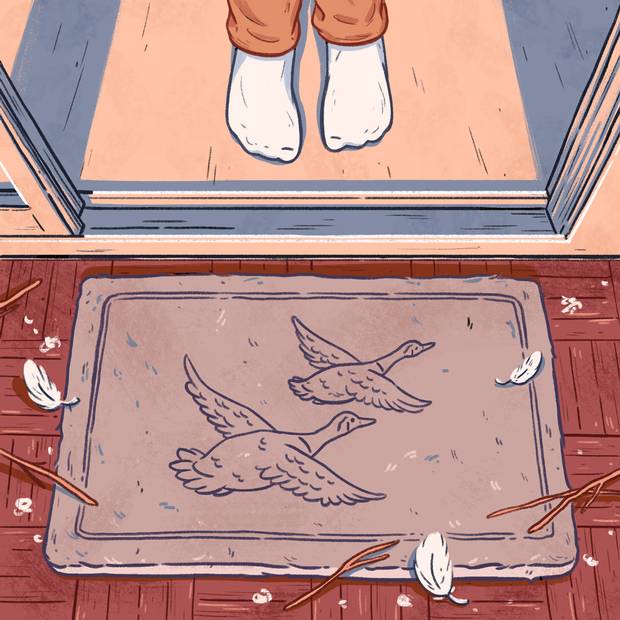Facts & Arguments is a daily personal piece submitted by readers. Have a story to tell? See our guidelines at tgam.ca/essayguide.
They are back, and our angst begins again. For the 13th year in a row, we will assist in the birth of a cluster of goslings that hatch on our apartment balcony.
Our seventh-floor balcony overlooks the water and it's a fitting spot to start a family. With no natural cliffs in the downtown Vancouver forest, a pair of Canadian geese decided that our perch had good views of potentially dangerous encroachers, close proximity to food sources and offered a quick exit to the sea.
Scouting out the finest nesting spots in our urban realm takes place as early as January by presumed goose mates. Abundant honking and wing flapping takes place.
This is mating season and these birds are not quiet about it. We wonder if the cacophony is more about jockeying for the best nest site or the most desirable mate.
We don't know much about goose mating and each year vow to do more research.
Our balcony seems to win out every year as a coveted nesting place and, over the span of a few weeks, a nest is meticulously assembled.
The perfectly round vessel is fashioned from bits and bobs from nearby planters and includes whimsical cosmopolitan touches such as shreds of plastic bags from the upscale grocery store, Urban Fare, nearby. Urban geese indeed.
By early April, five or six sizable eggs are laid, carefully covered with down, and mother goose squats on them for several weeks. She sits diligently, enduring all kinds of weather, and rarely leaves the nest. She is occasionally visited by her mate. Or so we think. Maybe it's some other guy. We are never sure and again, vow to learn more about goose mating.
Appreciating that the geese are nesting in an unnatural habitat, we have intervened in the nesting and birthing process. Thinking that mother goose might get a bit peckish between the infrequent food-scrap drops from her mate, we've offered up granola and Cheerios and a bowl of water to sustain her. Cheerios are her favourite. She devours them suspiciously, but with gusto. And such is the daily routine until Big Hatch Day. Our anxiety escalates as we prepare for the momentous event.
The first year the eggs hatched, we were away for the big day and came home to find six adorable goslings swimming around in the artificial pond beside our apartment. We raced upstairs to see whether all the eggs had hatched – they had! All six of our step-offspring survived.
It was wondrous to watch the wee goslings instinctively know how to swim and mimic their parents pecking on the grass for food.
How the young ones got down to the ground eluded us – the goslings have undeveloped wings – and we initially came up with all sorts of unscientific explanations. Perhaps magic carpet style on mom or dad's
back, or attached to their beaks? We didn't spend much time on due diligence thinking that the nesting incident was a one-off and the pair wouldn't return to our deck again.
We were wrong. Ma and Pa goose returned the next year and nested in the same place. This time, we made sure we hung around for the births and cleared our social calendar for several days on either side of the anticipated birth day.
When Big Hatch Day arrived, we were horrified to watch the wee goslings simply walk over the edge of the balcony to the beckoning bellows of their parents in the garden below. Luckily, the goslings's diaphanous bodies seemed to insulate them from the precipitous fall.
Some of the little birds looked a little disoriented after they hit the ground, but they shook themselves off and instinctively followed the directions of their parents.
It is a marvel to watch their progression. The little ones swim and feed for a few days in the enclosed pond and garden area, then, with mom at the lead and dad bringing up the tail end, cross the city's busy Seawall pathway with its bikers, joggers and dog walkers.
They head to the bigger pond of False Creek and the mighty Pacific beyond.
Now, we consider ourselves urban gosling birth experts. We are uber prepared each year. We have devised a system in which we spring into action the moment the little gosling heads peek out of the cracked eggs. While my spouse fends off the anxious mother, I scoop the newborns into a box and take them down in the elevator to meet father goose who is noisily beckoning for them from the inner courtyard.
Our strategy has worked every year and we are perfecting it, bit by bit. There have been some unanticipated incidents that we take in our stride. One year, I encountered a neighbour on the elevator who asked where I was going with a box of goslings. When I replied I was reuniting them with their parents, he said that a gosling had landed on his balcony. Back I went to fetch it and released the newborn to his family.
We are quite proud that our human intervention has been a positive asset to another species. Our neighbours look forward to the birth experience each year as much as we do.
The eclectic mix of creatures, both fowl and human, has made our neighbourhood a richer and more vibrant place.
Janis Connolly lives in Vancouver.
